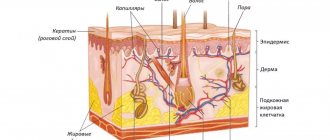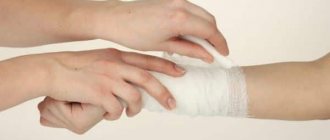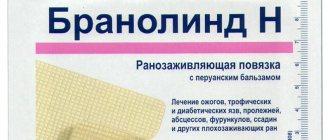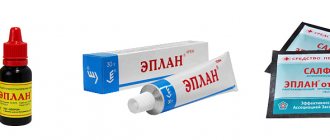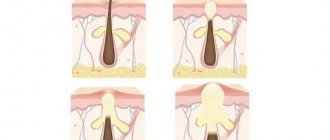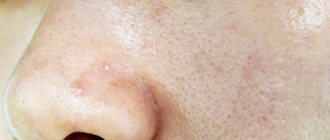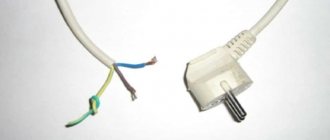A thermal burn is a specific injury to the skin and (sometimes) underlying tissue due to exposure to high temperatures. Sources of thermal effects can be both solids and liquids, as well as steam or gas. As a rule, contact with a carrier of excess heat occurs as a result of a violation of safety standards for working with its sources or as a result of an accident. Sunburns should also be partially classified as thermal. They arise due to the combined effect on the skin and mucous membranes of both ultraviolet rays, which themselves have a destructive effect on the body, and the thermal energy of solar radiation.
When exposed to thermal energy, the body primarily injures the skin (or mucous membranes). If the intensity of the thermal effect is high, then the injury can affect not only all layers of the skin, but also the tissues located underneath it. Depending on the depth of tissue damage, in clinical practice there are 4 degrees of burns, each of which has its own symptoms and clinical features, on the basis of which the treatment program is based. Therefore, before moving on to considering the treatment of thermal burns, you should familiarize yourself with them.
Degrees of thermal burns and their clinical manifestations
A first degree burn corresponds to a superficial lesion of the skin. It manifests itself as redness and swelling of the skin in the area of heat exposure. The burn site hurts, the victim complains of a burning sensation, which intensifies when touching the damaged skin. Gradually, the pain goes away; after a few days, the surface layer of the skin peels off and disappears, revealing healthy skin underneath.
A second degree burn also refers to superficial skin lesions. Unlike a first-degree burn, in addition to the redness of the burned area of the skin, one or more blisters filled with a cloudy liquid appear on it. The mechanism for the appearance of such bubbles is quite simple: in the place of the most intense exposure to heat on the skin, the liquid part of the blood sweats through the walls of the capillaries with peeling of the surface layer of the skin. If such a bubble ruptures, a weeping skin wound forms in its place. If a 2nd degree thermal burn was saved from infection, such damage heals without a trace, scarring occurs only if infection occurs and secondary inflammation develops with suppuration.
A third degree burn refers to deep skin lesions that involve the germ layer of the dermis. Cells of the burned skin area die with the formation of dry or wet necrosis. The skin near the area of necrosis is red or yellowish, and blisters may form on it. Considering that with this degree of burn, thermal damage affects the germ layer of the skin, healing without scar formation is impossible. The scope of treatment is determined depending on the extent of the burn; for large burns, skin grafting may be required.
A IV degree burn corresponds to charring of the skin and damage to adjacent tissues - subcutaneous tissue, muscles, ligaments, joints and bones. Necrotic tissue, disintegrating, becomes a source of powerful intoxication of the body, which can lead to the death of the victim.
First aid for a burn victim with boiling oil
We are talking about 1st and 2nd degree damage. The last stages are the work of professionals. The only thing that will ease the suffering of the victim in extreme cases is cooling and getting rid of oil-soaked clothing. If the fabric is “stuck” to the skin, you cannot tear it off. So, what to do in case of a burn with boiling oil is correct:
- The natural impulse is to cool the affected area. However, it should be remembered that ice or water at the same temperature will make the tissue rough, promoting the formation of scars or scars. The permissible parameter is 15–20⁰С. It is advisable to use running water or change the container several times into which the victim can lower the limb. A generously dampened cloth will also work.
- If the limbs are injured, I place them above the level of the heart. The arms and legs are fixed in a raised position. This measure will prevent the swelling from increasing, thanks to the normalization of blood circulation.
- Extensive damage is fraught with infection. However, you cannot use alcohol-containing liquids to disinfect a wound - the composition will dry out the skin even more and add pain. It is recommended to use hydrogen peroxide and immediately moisten and cool the burn area with a clean cloth moistened with water.
- You should not use fermented milk products to relieve pain. Sourdough will only add irritation. It is better to take well-known painkillers - Mig, Paracetamol and others.
- You cannot pop blisters on your own. They are covered with a dry cloth so as not to accidentally damage them.
If your home or work first aid kit contains anti-burn medications, use them immediately. Sulfargin, Bepanten, Levomekol Ichthyol ointment - suitable for treating 1st and 2nd degree burns. Actovegin is prescribed in more serious cases. Be sure to read the instructions before use.
First aid measures for thermal burns
The first thing to do is to stop the heat exposure on the victim. That is, avoid contact with open flames, hot objects, liquids or vapors. In addition, you should free the affected area of the body from clothing and jewelry - when heated, they continue to exert a thermal effect. If clothing is stuck to a burned area of skin, it cannot be torn off - the stuck area of fabric is cut off with scissors.
The second important first aid measure is to remove excess heat from the affected area as quickly as possible. At the physical level, thermal energy during a burn is transferred from a hotter object (heat source) to a less hot one (skin). And this thermal energy continues to destroy cells. To stop the destructive process, excess heat must be eliminated. To do this, the burned limb should be immersed in a container of cold water or placed under a stream of cold tap water. If we are talking about an area of skin on the stomach, back, thigh, cover it with a napkin soaked in cold water, which is changed as it warms up. Cooling the burned area, by the way, helps relieve pain. You can add ice to the cooling water, but you cannot wipe the burn area with a piece of ice or a handful of snow from the freezer: the edges of the ice crystals are quite sharp and can easily cause additional injury to damaged skin.
Also, do not lubricate the burn site with oil, sour cream, or rich cream. A film of fat on the surface of the skin will prevent the removal of excess heat. Fatty fermented milk products or creams are good for restoring skin after 1st degree burns (including sunburn) - but already in the phase of skin regeneration, and not as a first aid measure.
The next step is dressing. As a rule, first-degree burns do not require dressing, although it can be used to protect the burned area of skin from painful contact with clothing or any objects. Second-degree burns are bandaged in order to preserve the integrity of the blisters for as long as possible and thereby prevent infection of the burn wound. Third- and fourth-degree burns are treated in a medical facility; the decision to bandage in this case is made by the attending physician, depending on the chosen method of treating the burn wound (open or closed). You can apply ointment under the bandage to treat burns locally.
In case of intense pain, it is important to supplement the set of first aid measures for burns with pain relief. For small area I-II degree burns, a tablet of any over-the-counter analgesic or NSAID is usually sufficient. For deeper or more extensive burns, pain relief is carried out by doctors, often using narcotic analgesics, which avoids the development of pain shock in the victim.
Regardless of the degree and area of the burn, it is important to provide the victim with enough fluids. Firstly, burned skin intensively loses moisture and with extensive burns dehydration can develop in a short time. Secondly, any burn is associated with the release of a large amount of toxins into the blood, and restoring the water balance in the body reduces the effects of intoxication.
Burns are treated using medical methods, folk remedies, pharmaceutical and cosmetic products. There is no clear answer as to which method is more effective. It depends on the severity, localization of the defect, and skin characteristics. Let's look at each method in more detail.
Medical methods
Medicine and cosmetology offer two methods of getting rid of scars: radical, that is, surgical intervention, and cosmetic procedures.
Surgery is indicated for burns of the third or fourth stage, for hypertrophic, keloid scars.
To remove scars, the patient does:
- Skin grafting. The tissue is taken from a healthy area and moved to the post-burn area.
- Excision – removal of scar tissue, application of a cosmetic suture.
- Laser resurfacing – smoothing the skin by removing part of the epidermis and dermis.
- Microdermabrasion – gentle polishing with microcrystals.
Before carrying out procedures, consult your doctor. He will select the best way to remove a cosmetic defect.
Folk recipes
To treat burns, some prefer to resort to folk remedies. Among them there are quite a lot of effective ones, for example:
- Masks based on badyagi. Accelerate metabolic processes, regeneration, and blood supply to tissues.
- Compresses with camphor oil. Prevents inflammation, nourishes the skin, and quickly heals wounds.
- Composition of chicken egg shells and melon seeds. To prepare, grind the ingredients, then add vegetable oil to the mixture. The course is about two months.
If the scar has appeared recently, it is easier to get rid of it. Therefore, there is no need to delay treatment. Otherwise, surgery may be required.
Creams and ointments for scars and burns
If the post-burn defect was not eliminated, a scar remains, the situation can be corrected even at home. For this purpose, effective ointments, creams for scars and burns are used. If the case is complex, plastic surgery cannot be avoided.
Doctors prescribe absorbable drugs with a regenerative effect, usually immediately after the wound has healed. For keloid scars, products with a silicone base are used, which inhibits pathological tissue growth. Drugs are selected taking into account the characteristics of the patient’s body to avoid side effects.
The following drugs are most often used at home to remove post-burn cosmetic defects:
Cream for scars and burns, hyperpigmentation Lakshma Maxi. A popular product for lightening, including in delicate areas. Eliminates scars without risk to health, reliably and quickly. The result becomes visible after 18 days. The effectiveness of the product is 95%. The cream is easy to use. The product is applied every day before bed to the area that needs lightening. The composition does not contain alcohol, parabens, hydroquinone, the drug does not cause an allergic reaction, and is suitable for different skin types. Active components - kojic acid, vitamins, natural bioactive ingredients. The product is made from natural raw materials. Used for both fresh and old scars.
Contractubex. It contains onion extract and allantoin, which soften healed tissue well and accelerate regeneration processes. Used for different scars, applied twice a day. The effect will be noticeable after a month of use.
Strataderm. Used to get rid of hypertrophic scars and keloids. Contains silicone. The film that appears after applying the cream prevents the scar from growing. Moisturizes and softens rough tissues, dissolving keloids. Apply twice a day for 2-3 months. The maximum therapeutic course is 6 months.
In addition to the listed drugs, cosmetic defects are eliminated with essential oils with a brightening effect - sea buckthorn or jojoba oil, parsley, cucumber extracts, liquid vitamins in ampoules E and A. The products are often used in combination.
Treatment of thermal burns
Of course, the main task and goal of treating a thermal burn is to restore the integrity of the skin. For superficial burns that do not involve the germ layer of the skin, regeneration occurs independently. If the burn damages the germ layer, healing is only possible through scarring, so with extensive deep burns there is a need for skin grafts.
In addition to measures aimed at restoring tissue integrity, treatment of burns has a number of other goals:
- pain relief;
- normalization of hemodynamics;
- restoration of water and electrolyte balance;
- normalization of blood pH;
- restoration of protein metabolism;
- prevention of liver, heart, lung, and kidney failure;
- detoxification of the body.
The first step in treating deep thermal burns is to thoroughly clean the burn wound. Foreign bodies, pieces of tissue, and exfoliated epidermis are removed from its surface under aseptic conditions and under local anesthesia. The wound is washed with hydrogen peroxide, after which the doctor decides on the method of further therapy. With the open method, a bandage is not applied to the area of burned skin. The closed method of therapy involves applying anti-burn ointment and subsequent dressing.
